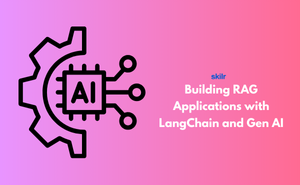👇 CELEBRATE CLOUD SECURITY DAY 👇
00
HOURS
00
MINUTES
00
SECONDS

Creating RAG Applications with LangChain and Generative AI focuses on developing AI systems that can pull the right data and then explain it in simple, human-like language. Instead of depending only on pre-learned knowledge, these applications search through external sources in real-time to find correct answers. This makes them more reliable and practical for industries that require accuracy, like finance, healthcare, and education.
With LangChain, developers get a toolkit that helps link AI with outside databases, APIs, and custom workflows. When combined with Gen AI models, it creates powerful solutions capable of answering tough questions, assisting businesses, and improving decision-making. These tools open the door for building AI applications that are smarter, context-aware, and business-ready.
This exam is ideal for:
Domain 1 - Introduction to RAG Applications
Domain 2 - Getting Started with LangChain
Domain 3 - Generative AI Basics
Domain 4 - Combining Retrieval and Generation
Domain 5 - Working with Databases and APIs
Domain 6 - Building Intelligent Applications
Domain 7 - Evaluation and Optimization
Domain 8 - Advanced RAG Concepts
Industry-endorsed certificates to strengthen your career profile.
Start learning immediately with digital materials, no delays.
Practice until you’re fully confident, at no additional charge.
Study anytime, anywhere, on laptop, tablet, or smartphone.
Courses and practice exams developed by qualified professionals.
Support available round the clock whenever you need help.
Easy-to-follow content with practice exams and assessments.
Join a global community of professionals advancing their skills.
Yes, most LangChain applications are built with Python.
Yes, entrepreneurs can build AI-driven apps for customer service, analytics, or productivity.
Healthcare, finance, education, research, and customer support.
Yes, it equips them to build advanced AI-powered solutions.
Chatbots, virtual assistants, research tools, and smart search apps.
Yes, it includes discussions on responsible and safe AI practices.
Definitely, RAG and LangChain skills are in high demand.
No, a basic understanding of programming and AI is enough.
It simplifies building AI apps by connecting models with tools and data.
Yes, as long as they have basic programming knowledge.